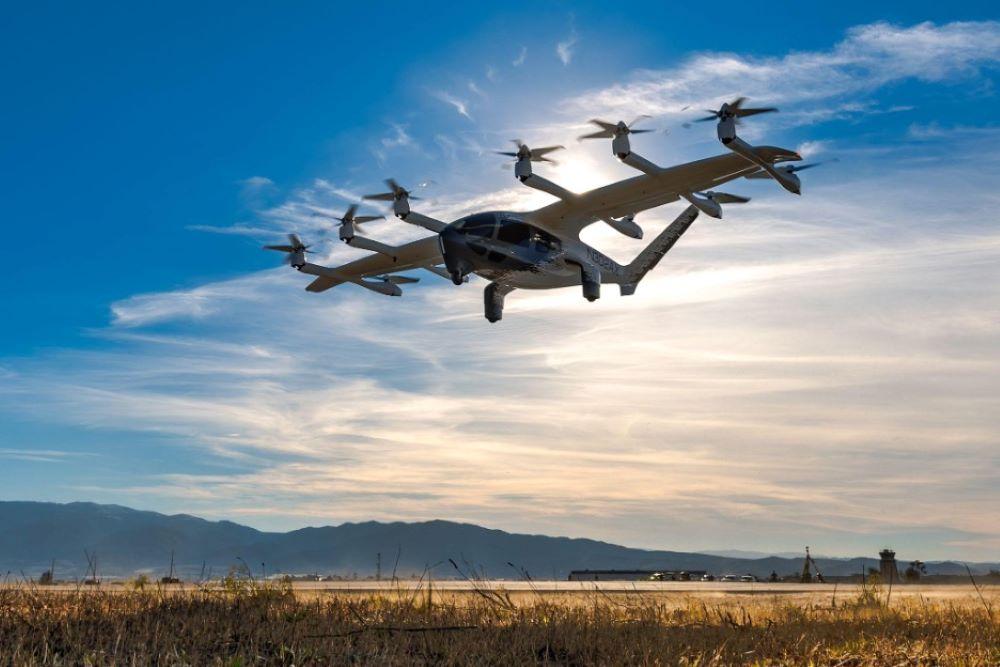
The six battery packs on Archer’s Midnight each contain more than 1,000 cylindrical cells produced by Molicel.
Archer Aviation has signed a Space Act Agreement (SAA) with NASA allowing it to use the agency’s test facilities to evaluate the safety and performance of battery cells that will power the Midnight electric vertical-takeoff-and-landing (eVTOL) vehicle.
The Midnight has six of Archer’s proprietary battery packs, each of which contains more than 1,000 cylindrical lithium-ion cells developed by Molicel. The batteries power 12 electric motors, which in turn drive 12 propellers on the wing, six of which tilt between vertical and forward flight, and six of which are fixed in a lift-only configuration.
Under an SAA, NASA provides commercial entities with spare facilities and equipment to further develop technologies it considers to have broad public benefits. Archer’s SAA will begin with an initial project focused on studying high-performance battery cells and safety testing targeted for advanced air mobility (AAM) and space applications.
Tests of the safety, energy and power performance of battery cells will be performed using the European Synchrotron Radiation Facility in Grenoble, France, which Archer described as “one of the most advanced high-speed X-ray facilities in the world.”
Archer said in a statement that NASA’s goal is to “test Archer’s battery cell and system design and share the results to push the entire AAM industry forward. Maturing battery technology is anticipated to be a key enabling factor for the mass production and adoption of electric aviation.”
Speaking to the AAM Report following the announcement, Archer co-founder and CEO Adam Goldstein said that the agreement with NASA will initially focus on proving out the safety advantages of the cylindrical cells supplied by Molicel, while eventually moving beyond the cells to prove out safety across the broader aircraft.
“This agreement really allows NASA, Molicel and Archer to all work together and validate the safety of the cells and figure out how to keep encouraging Molicel to make safer and safer cells,” Goldstein says. “That’s the starting point, and from there we’ll move on to the other systems on the aircraft.”
Goldstein said that Archer’s agreement with NASA, as well as its existing relationships within the Department of Defense, demonstrate the U.S. government’s determination to maintain global leadership in AAM by working with the leading domestic air taxi companies on technological development.
Archer has identified the battery supply chain as a potential industry-wide obstacle for scaling production of eVTOLs. Many of the raw materials needed for batteries are found outside the country–notably in China, where they have a more mature electric vehicle (EV) supply chain and battery industry. On top of that, the nascent AAM sector will have to compete for available batteries with the much larger and more established EV industry.
Fortunately, Goldstein said that Archer’s close relationship with manufacturing partner Stellantis–which recently acquired a 20% stake in Chinese electric automaker Leapmotor–will help ensure that it has sufficient access to batteries at an affordable price point.
“Partnering with Stellantis gives us access to some of their supply chain, and they’re a global company with amazing buying power, so they can carve stuff off for us when they do deals—that kind of thing,” Goldstein says.
Less than a month into 2024, the Archer CEO believes the industry is at a crossroads. The short list of well-capitalized eVTOL startups will continue to make real progress toward certification, while separating themselves from the larger pack of companies that are unlikely to ever raise enough money to certify their vehicles, he predicts.
“I think you’re going to see the winners keep winning, and it’ll be a tough road for some of the other groups,” Goldstein says. “It’s very expensive to do this. You can look at what Archer and Joby have spent so far and compare that to everyone else. Most companies do not have the ability to raise that kind of capital, and it’s not getting any easier for them … I think you’ll see the big companies keep getting bigger and leaving the rest behind.”





